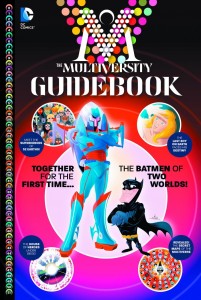 The Multiversity Guidebook #1 (of 1) — Writer: Grant Morrison; Artists: Marcus To and Paulo Siqueira; Colors: Dave McCaig and Hi-Fi
The Multiversity Guidebook #1 (of 1) — Writer: Grant Morrison; Artists: Marcus To and Paulo Siqueira; Colors: Dave McCaig and Hi-Fi
This is expensive ($7.99) but also awesome — more than just a guidebook, it’s a 34-page story spotlighting the Batman: L’il Gotham characters (who turn out to be from Earth-42), plus Kamandi (Earth-51), whose story summarizes the history of alternate Earths in the DC Universe since “Flash of Two Worlds,” plus the Batman from the Atomic Knights timeline (Earth-17), plus the Legion of Sivanas and other tie-ins to the other “Multiversity” books Morrison has been producing; these all make it an essential (and, although it starts out cute with the “L’il Gotham” team, ultimately very creepy) chapter in the overall story. Add in the other 32 pages, which are a guidebook to the 52 alternate Earths, complete with pinups and histories of each super-team, and the result is a densely-packed, information-rich and entertaining production.
 Casanova IV: Acacia #1 — Writer: Matt Fraction; Art: Fabio Moon; Colors: Cris Peter (Back-up story) — Writer: Michael Chabon; Art: Gabrial Ba; Colors: Cris Peter
Casanova IV: Acacia #1 — Writer: Matt Fraction; Art: Fabio Moon; Colors: Cris Peter (Back-up story) — Writer: Michael Chabon; Art: Gabrial Ba; Colors: Cris Peter
This is Fraction’s original indy baby, begun almost ten years ago, before he started working for the big companies and became a star, and it’s a pleasure to have it back. The title character is a very Michael Moorcockian time- and dimension-traveling playboy and spy, and this series picks up right from the end of the last one, with our hero, now an amnesiac, working as a driver for a Hollywood bigshot; mix in some decadence, an attempted murder, a couple of occult assassins and an impending apocalypse, and we’re off. Fraction’s story-telling power has grown over time, and Moon’s art is always a joy; mix in the back-up by Pulitzer winner Chabon, and its Ba art, and you have one very cool and stylish comic book.
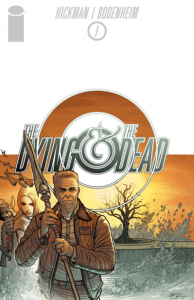 The Dying and the Dead #1 — Writer: Jonathan Hickman; Art: Ryan Bodenheim; Colors: Michael Garland
The Dying and the Dead #1 — Writer: Jonathan Hickman; Art: Ryan Bodenheim; Colors: Michael Garland
No one’s ever accused Hickman of being stingy, in either concepts or story: this first issue of a new series offers 59 pages (with no ads until the very end) in full, striking color, for $4.50. The narrator is an aging ex-military man (addressed only as “Colonel”) whose wife is dying of cancer; he’s approached by a shadowy group of immortals/string-pullers who’ve encountered him in the past, and want him to track down a stolen mystical item for them — in return, they’ll cure his wife. Bodenheim’s worked with Hickman before (on both Red Mass for Mars and Secret), and they have a good rhythm together: pages are often a series of four tiers, one panel per tier, for the conversation and smaller action, and then a single or double-page splash to establish a setting or strike a climax. It’s effective, and all the design elements are thought through so carefully, from the script to the art to the color, that the result is a very attractive, satisfying piece of work. Now, if they can just keep to a reasonable schedule (*cough* Secrets *cough*…).
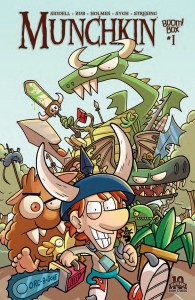 Munchkin #1 — Writers: Tom Siddell, Jim Zub; Art: Mike Holmes, Rian Sygh
Munchkin #1 — Writers: Tom Siddell, Jim Zub; Art: Mike Holmes, Rian Sygh
Munchkin is a Magic The Gathering-like card game that’s a parody of role-playing games generally, and D&D stuff in particular; it’s published by Steve Jackson games, has been around for maybe 15 years, and has about a million expansion packs, sequels, etc. It’s long on humor and short on complexity, and very popular, and this comic offers a decent taste of its charms; if you like Knights of the Dinner Table or Dork Tower, you’ll appreciate it, too. It doesn’t hurt that this first issue contains an actual “Go Up a Level” card that can be used in the game itself….
 Vertigo Quarterly: Black #1 (of 1) — Creators: Various
Vertigo Quarterly: Black #1 (of 1) — Creators: Various
This is the final of Vertigo’s anthology series where each issue has focused on one of the primary colors in “four-color” comics: cyan, magenta, yellow and now black; stories are free to make that hue an integral part of the story, just background, or whatever else, as long as they use it. As with the others, there are nine different contributions, most eight pages long. Francesco Francavilla (of Afterlife With Archie, among others) offers the lead-off piece, which goes by quickly but effectively, while Gene Luen Yang (whose American Born Chinese graphic novel almost ten years ago won an Eisner and a bunch of mainstream awards) provides probably the best piece, a love story about loss and acceptance with art by Sonny Liew. Fans of Jeff Lemire’s Sweet Tooth will appreciate the next story, because it’s a prequel to that series; other contributions are from Steven Seagle and Teddy Kristiansen; David Baillie and Will Morris; Mary Choi and Ana Galvan; Tom King and John Paul Leon; Si Spencer and Nimit Malavia; and, as the finale, Fabio Moon, who closes the book and the series with the final installment of the quiet, effective story he’s been telling through all four issues. Like Multiversity Guidebook, this isn’t cheap ($7.99), but there’s more than enough good stuff here to justify the cost.
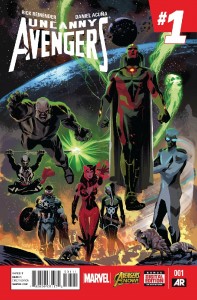 Uncanny Avengers #1 — Writer: Rick Remender; Art/Colors: Daniel Acuna
Uncanny Avengers #1 — Writer: Rick Remender; Art/Colors: Daniel Acuna
This isn’t precisely “new,” since the title’s just relaunching after the events of “Axis” (and the first volume was only around for two years), but it’s a new iteration of the team: the Sam Wilson Captain America, an “inverted” Sabretooth, the Vision, the Scarlet Witch, Quicksilver and Rogue. Remender wastes no time on recaps, jumping right into a plot involving Counter-Earth and the High Evolutionary’s New Men, one that splits up the heroes and subjects them to various menaces. Acuna has a slightly looser style than most mainstream superhero artists, and he’s good at drawing the animal-derived New Men and one of the bad guys, a cackling, beak-nosed high priest type; there should be enough here to convince fans of the original volume to keep reading it.
 Bitch Planet #2 — Writer: Kelly Sue DeConnick; Art: Valentine de Landro; Colors: Cris Peter
Bitch Planet #2 — Writer: Kelly Sue DeConnick; Art: Valentine de Landro; Colors: Cris Peter
They’re Not Like Us #2 — Writer: Eric Stephenson; Art: Simon Gane; Colors: Jordie Bellaire
Abigail and the Snowman #2 — Writer/Artist: Roger Langridge; Colors: Fred Stresing
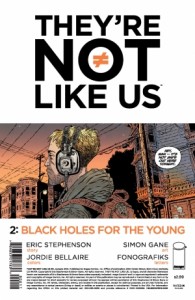 Gotham By Midnight #3 — Writer: Ray Fawkes; Art/Colors: Ben Templesmith
Gotham By Midnight #3 — Writer: Ray Fawkes; Art/Colors: Ben Templesmith
These are grouped because they’re all second or third issues of new titles; Bitch Planet, which had a critically-lauded debut (it used the trick of killing off the person the reader thought was going to be the main viewpoint character, and did it effectively), builds on that momentum, as we find out more about how society developed its current  patriarchy, and events are set in motion that might let the women break free. DeConnick’s put a lot of thought into her world-building here (and mentions in the editorial material that she’s figuring on around 30 issues to tell her story), and she has a good partner in de Landro (a sequence where the real main character is jogging, and getting advice from a couple of other inmates, takes place as, in the far background, a full-scale prison riot breaks out and progresses; it’s subtly done and makes a point about how matter-of-factly violence occurs in this setting). Overall, the combination of feminist theme and women-in-prison plot combine to give
patriarchy, and events are set in motion that might let the women break free. DeConnick’s put a lot of thought into her world-building here (and mentions in the editorial material that she’s figuring on around 30 issues to tell her story), and she has a good partner in de Landro (a sequence where the real main character is jogging, and getting advice from a couple of other inmates, takes place as, in the far background, a full-scale prison riot breaks out and progresses; it’s subtly done and makes a point about how matter-of-factly violence occurs in this setting). Overall, the combination of feminist theme and women-in-prison plot combine to give 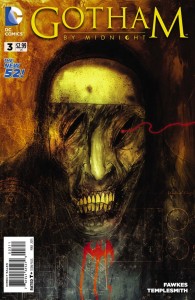 this both weight and a fizzy B-movie energy. They’re Not Like Us, about a girl tormented by psychic powers who falls in with a gang of similarly-powered young adults, is mostly talking, as Stephenson lays out the pros and cons of their outside-the-law lifestyle (good: she has a place to belong and can live a life of luxury; bad: she has to kill her parents to stay), so it’s kind of treading water. Abigail and the Snowman continues its very British story about a little girl who befriends a yeti, who’s cultured, pursued by government forces, invisible to adults and visible to kids, with the same gentle humor as in its first issue. The most intriguing of this group is Gotham by Midnight, with Fawkes’s occult themes perfectly accented by Ben Templesmith’s spooky, sketchy, uniquely-comics horror style.
this both weight and a fizzy B-movie energy. They’re Not Like Us, about a girl tormented by psychic powers who falls in with a gang of similarly-powered young adults, is mostly talking, as Stephenson lays out the pros and cons of their outside-the-law lifestyle (good: she has a place to belong and can live a life of luxury; bad: she has to kill her parents to stay), so it’s kind of treading water. Abigail and the Snowman continues its very British story about a little girl who befriends a yeti, who’s cultured, pursued by government forces, invisible to adults and visible to kids, with the same gentle humor as in its first issue. The most intriguing of this group is Gotham by Midnight, with Fawkes’s occult themes perfectly accented by Ben Templesmith’s spooky, sketchy, uniquely-comics horror style.
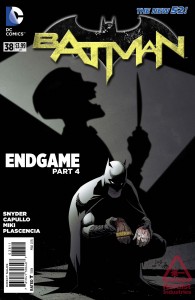 Batman #38 — Writer: Scott Snyder; Pencils: Greg Capullo; Inks: Danny Miki; Colors: FCO Plascencia
Batman #38 — Writer: Scott Snyder; Pencils: Greg Capullo; Inks: Danny Miki; Colors: FCO Plascencia
Continuing the “Return of the Joker” arc: he knows Batman is Bruce Wayne, he’s infected most of Gotham with Joker venom that (a) drives people crazy and (b) will soon kill them, and he’s left our hero with few options — except, on the last page, enlisting some unlikely allies. This is, as always, well done, but the whole “Gotham Apocalypse” plot seems a little soon, coming on the heels of the similar “Zero Year” Riddler story a few months ago (Why would anyone live in Gotham? It’d be like living in San Francisco if it had an earthquake every month…). There’s also a swerve to a quasi-mystical “Gotham’s always had a Joker” retcon that feels a little off; it’s effectively creepy in the short term, but those kinds of add-ins often pose a longterm problem, accumulating around and obscuring a book’s central themes like barnacles on a ship. There are two more chapters in this tale, though, and this creative team’s kept the book on the top of the charts for more than three years, so maybe they know what they’re doing after all….
 Sex Criminals #10 — Writer: Matt Fraction; Art/Colors: Chip Zdarsky
Sex Criminals #10 — Writer: Matt Fraction; Art/Colors: Chip Zdarsky
Mind MGMT #30 — Writer/Artist: Matt Kindt
Two quirky, well-done indy titles: Sex Criminals has been the more successful, garnering wide critical praise despite (or, maybe, because of) its fond, unblinking treatment of its high-concept idea (people who can, literally, stop time when they orgasm): when your house ads for your comic can include positive pull quotes from Rolling Stone and Time, and tout your Eisner and Harvey awards, plus your New York Times and Publisher’s Weekly bestseller status, you’re clearly doing something right. This issue concludes the book’s second arc (the trade will be out next month), and it’s mostly been about Jon  and Suzie figuring out what to do next, once the initial glow of their unique relationship starts to fade; it’s also been about introducing new characters, establishing their histories, and firming up their alliances with the main couple as they prepare to fight the bad guys. Mind MGMT isn’t a best-seller, but it’s one of the most unique books on the stands, and the fact that it’s made it to 30 issues makes me optimistic for the American comics market, and its ability to support cool-but-uncommercial stuff. This issue looks at the history of one the women antagonists, and because it’s a series of memories Kindt experiments with a combination of watercolor, colored pencil, charcoal and goache to illustrate it; this gives it a dark, dreamlike feel that’s utterly fascinating, and a great example of the comic’s willingness to experiment, while still telling a compelling psychic-spy story; try it out, and give it your support.
and Suzie figuring out what to do next, once the initial glow of their unique relationship starts to fade; it’s also been about introducing new characters, establishing their histories, and firming up their alliances with the main couple as they prepare to fight the bad guys. Mind MGMT isn’t a best-seller, but it’s one of the most unique books on the stands, and the fact that it’s made it to 30 issues makes me optimistic for the American comics market, and its ability to support cool-but-uncommercial stuff. This issue looks at the history of one the women antagonists, and because it’s a series of memories Kindt experiments with a combination of watercolor, colored pencil, charcoal and goache to illustrate it; this gives it a dark, dreamlike feel that’s utterly fascinating, and a great example of the comic’s willingness to experiment, while still telling a compelling psychic-spy story; try it out, and give it your support.
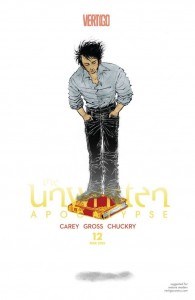 Unwritten: Apocalypse #12 (of 12) — Writer: Mike Carey; Art: Peter Gross; Colors: Chris Chuckry
Unwritten: Apocalypse #12 (of 12) — Writer: Mike Carey; Art: Peter Gross; Colors: Chris Chuckry
This is worth its own entry because it’s the book’s finale — after five and a half years, and 70-some issues. Like this same team’s Lucifer (which went 78 issues), it’s been one overall story broken into smaller arcs, and Gross’s illustrations, full of grotesques and supple high fantasy, make a good balance for Carey’s tough-minded fairy-tale plots. Somehow, it never felt like compelling, top-of-the pile reading like Lucifer did, but its takes on father-son relationships, heroic responsibility and the power of storytelling were always smart and imaginative, and it’s good to see it come in for a poised three-point landing; may it have a long life in the trade collections.
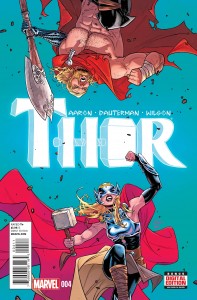 Thor #4 — Writer: Jason Aaron; Art: Russell Dauterman; Colors: Matthew Wilson
Thor #4 — Writer: Jason Aaron; Art: Russell Dauterman; Colors: Matthew Wilson
Secret Avengers #12 — Writer: Ales Kot; Art: Michael Walsh; Colors: Matthew Wilson
Uncanny X-Men #30 — Writer: Brian Michael Bendis; Pencils: Chris Bachalo; Inks: Tim Townsend with four other guys; Colors: Bachalo and Antonio Fabela
 New Avengers #29 — Writer: Jonathan Hickman; Pencils: Kev Walker; Inks: Walker and Scott Hanna; Colors: Frank Martin
New Avengers #29 — Writer: Jonathan Hickman; Pencils: Kev Walker; Inks: Walker and Scott Hanna; Colors: Frank Martin
The best of the rest: Thor has the regular, and now former, thunder god fighting his distaff replacement, while the Dark Elves and the Frost Giants invade Midgard; Aaron and Dauterman bring its first arc to a satisfying conclusion. Secret Avengers is at the part in the plot where the heroes start to  cooperate, turn things around and get set up for the big final blowout, and is a good example of Marvel’s current upscale house style: pages with lots of small panels followed by cinematic one- or two-page splashes, with bright colors, clear-lined, minimalist art and strong storytelling, equal parts comedy and character-based drama. Uncanny continues a long story about a super-powerful mutant and featureswith a visit to the past’s Professor X and the apparent death of Cyclops, although I don’t think too many of us are
cooperate, turn things around and get set up for the big final blowout, and is a good example of Marvel’s current upscale house style: pages with lots of small panels followed by cinematic one- or two-page splashes, with bright colors, clear-lined, minimalist art and strong storytelling, equal parts comedy and character-based drama. Uncanny continues a long story about a super-powerful mutant and featureswith a visit to the past’s Professor X and the apparent death of Cyclops, although I don’t think too many of us are 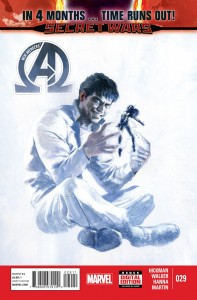 worried about that just yet; Bendis’s script is OK, but it’s the Bachalo art that really makes it sing. Meanwhile, and last, New Avengers has the fugitive Illuminati and the Steve Rogers-led S.H.I.E.L.D. finally start to cooperate and exchange notes to stave off the destruction of their universe; I thought the character on the cover was Maximus the Mad, but it turns out it’s another well-known player completely, one we haven’t seen for quite a while, and a sign of how this title’s endgame in a few months will dovetail into the big company-wide Secret Wars crossover this summer.
worried about that just yet; Bendis’s script is OK, but it’s the Bachalo art that really makes it sing. Meanwhile, and last, New Avengers has the fugitive Illuminati and the Steve Rogers-led S.H.I.E.L.D. finally start to cooperate and exchange notes to stave off the destruction of their universe; I thought the character on the cover was Maximus the Mad, but it turns out it’s another well-known player completely, one we haven’t seen for quite a while, and a sign of how this title’s endgame in a few months will dovetail into the big company-wide Secret Wars crossover this summer.



